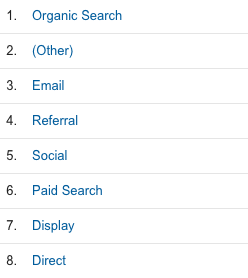When your boss asks you for the ROI of your latest social media campaign, how do you respond? Too many people who get asked that question fall back on the easy answers: this many new Twitter followers, this many retweets, this many Facebook shares, etc. Sure, these metrics offer surface insights into how a campaign or piece of content performed, but they don’t really show executives how your efforts are helping boost the bottom line.
“Return on investment” means a lot of different things to a lot of different people, especially when it comes to social media, where there isn’t decades of data to help you set goals and mark your successes. According to Altimeter, only 34 percent of businesses feel that their social strategy is connected to business outcomes. To prove ROI, you you need to show these connections to business outcomes by setting the right goals and the right key performance indicators (KPIs). These KPIs should always tie your social media efforts to broader marketing goals, and ideally to the money in your business’ bank account.
Here are 4 social media metrics—metrics that matter to your business—that you may be forgetting about:
Click-through with bounce rate

If you share original content to social media, you’re probably already tracking how many people click-through to that content. Click-through rates are important as a metric, since they indicate that your social media messaging is compelling enough to spark interest with your audience. The more clicks your content gets, the more you learn about what content themes interest your followers, what kind of social media messaging and images they respond to, what time of day they’re most likely to respond to your content, and more. Powerful stuff.
And yet, click-through becomes a far more telling metric, at least in terms of ROI, when paired up with bounce rate.
Bounce rate refers to the percentage of page visitors who leave your website after only viewing one page. In the case of social media, it would reflect someone clicking on a link you post to Twitter or Facebook, arriving on your website or blog, then leaving without viewing any other content.
Ideally, we all want people to stay on our sites forever (or until they convert—whichever comes first). Bounce rate an important metric to be tracking for your web properties, in general, but why is bounce rate important specifically as it relates to social media? It allows you to powerfully illustrate the ROI of your social media efforts by comparing it to your other sources of web traffic.
Track the bounce rate of website visitors who came from social networks, and compare that rate to website visitors who visited your site directly, arrived from Google, or arrived from any paid advertising campaigns. If your social media bounce rate is lower than those other sources, you can show your boss that you’re targeting the right people on social media, and the traffic you’re driving is more valuable to the business.
 To track this metric, you need to be set up on Google Analytics or another analytics provider. In the case of Google Analytics, you’ll want to go to the “Acquisition” tab, and look under “All Traffic” for the “Channels” segment. Click on the “Bounce Rate” button and it should rank all of the channels from lowest bounce rate to highest.
To track this metric, you need to be set up on Google Analytics or another analytics provider. In the case of Google Analytics, you’ll want to go to the “Acquisition” tab, and look under “All Traffic” for the “Channels” segment. Click on the “Bounce Rate” button and it should rank all of the channels from lowest bounce rate to highest.
In the example below, you would be able to show your boss that social media is less effective than search and email, but more effective than search ads, display ads and direct traffic to your website. That kind of insight should go a long way to showing your boss the value of social media to your business.

A high bounce rate will also indicate that you’re probably not targeting the right social media audience, or that your content is misleading/of a poor quality. These are things that all of us can work to improve week to week, month to month.
Share of traffic driven

If search has a bounce rate that’s twice as high as social media, but drives 20 times the traffic, social is still going to look less valuable in comparison. That’s why social media managers need to start tracking the share of traffic driven through social networks.
Share of traffic, once again, puts social up against other marketing channels like search or display ads, in order to determine the real value of a channel for your business. If you have 100,000 website visitors this month, and saying social drove 25,000 website visits might not be as powerful as saying that social drove 25 percent of website traffic this month, second only to search and well ahead of any other channel. That drives home the real impact of social media on this marketing objective.
Tracking share of traffic driven can be done in the same place as your bounce rate. Within Google Analytics, under Acquisition and Channels, click on the “Sessions” field. This will rank all of the channels based on the number of sessions they drive. In the column, beside the actual number, you should also be able to see a small percentage figure. This percentage represents the share of traffic being driven by each channel. Easy, peasy.
We’d be remiss not to mention that both share of traffic driven and bounce rate have one important caveat however: you only want to show your boss if they tell a positive story. Your social networks may never drive as much traffic or as high-quality traffic as search, but ideally social will surpass email and display ads in both of those realms. Until it does, in your particular case, you may want to hold off on sharing these metrics with the people upstairs, and use this insight to help you improve your social campaigns instead.
Social share of voice

Now that you’ve shown social’s value compared to other channels within your business, it’s time to look to the outside world. Social share of voice is a very valuable metric to show how your social media efforts stack up against those of your competitors. Put simply, it details what percentage of mentions within the industry are about your brand and what percentage are about the competition.
If I’m McDonalds, to calculate social share of voice I’m going to want to calculate all the mentions of my brand, as well as those of competitors like Burger King, Wendy’s and Arby’s. Once I have all of those mentions, I’m going to add them all up for the total number of industry mentions. Then, I’m going to calculate the number of McDonald’s mentions as a percentage of that total (you can do that by dividing your mentions by the total, and sliding the decimal point two spots down).
So why is social share of voice so important? It allows you to show your boss first, that all of your competitors are also on social media, and second, that you’re doing it better than they are. Through this one metric, you can eliminate doubts about whether it’s worth being on social media (if we’re not there for clients and prospects, you can bet our competitors will be), and show just how well your social efforts are being received. Tracked over time, social share of voice can be a powerful illustration of your social campaigns paying off, as you surpass competitors and become a leader in your industry.
Leads and attributed revenue

Leads are the lifeblood of your sales team. Leads are driven down the sales funnel until a special few become sales, and then you can throw a little dollar figure beside your work. If you’re trying to prove social media’s value to your business, delivering a fresh batch of warm leads is a surefire way to turn the right heads. Of course, that’s easier said than done.
First, make sure lead-generation is one of your social media goals. This will show your bosses that you’re serious about contributing to the bottom line, and should make it easier to justify an investment of time and resources into your social campaigns. Plus, by making it a goal, you force yourself to think about how you’re going to achieve it, and how you’re going to measure it.
Generating leads through social media can be achieved in several different ways:
- sharing gated content
- promoting contests with a form fill entry
- hosting social media events that require registration, like broadcasted Google hangouts
- using social media advertising to target prospects with free demos or free trials
Regular content can also generate leads, by driving people to web properties where they eventually tick enough boxes and share enough information to become leads. These leads are, unfortunately, a little harder to track.
The key to tracking leads is ensuring that the links you share are trackable within your marketing automation or analytics software—be it Google Analytics, Marketo, Salesforce or something else. To track the leads you’re generating, every link you share on social media should include a utm code. This code will follow anyone who clicks that link as they visit your website and become a lead, either right away or later on their journey. This allows you to attribute leads to individual social media messages or campaigns.
Within Hootsuite, you can add custom utm parameters to any link you share. To do so, click into the link shortener box and then hit the little cog symbol for settings. You should then see the option to add custom URL parameters by typing a utm code into the field before shortening your link.
Once you’ve identified how many leads you generated through social media, you’re only half way there. Saying that you generated 40 leads is a lot less powerful than saying you generated $4,000. In other words, you’re going to want to attribute revenue to your lead generation campaigns to round out this metric.
Ask your sales team how much revenue can be attributed to a lead generated through social media. This figure will loosely represent the amount of attributable revenue generated in a specific time divided by the number of social media leads generated during that time. You can then apply that value to the number of leads you generated for a campaign, a month or a quarter, and share the metric as attributed revenue. Though the figure might not be completed accurate, it allows you to attach a dollar figure to your social media efforts, which is invaluable for showing the effect of your social media investment.
Moving forward with these metrics
To really make use of these metrics, you must approach your social media strategy with a measurable goal for each. Then, track the metric over time and see how your efforts have progressed. You need to constantly assess and reassess your performance to ensure that you’re learning from this data and constantly improving. Otherwise, there’s really no point in tracking them at all.
The four metrics discussed above are widely under-utilized by businesses, but can help you identify where your social media strategy needs improvement, while emphasizing the overall value of social media to your business.
For more insight into social media analytics, check out our white paper “How Hootsuite Wins With Social Data.”